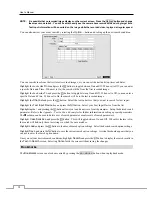
User’s Manual
64
Network Camera:
Selecting
(Display)
→
Network Camera
and choosing the camera number displays the
selected network camera full screen. It is the same as pressing the individual camera buttons on the front panel or
clicking the left mouse button on a camera image when in one of the multiview formats (i.e., 2x2, 3x2, 3x3, 4x3 or
4x4). Clicking the left mouse button on the screen again returns to the previous display mode.
NOTE: “Network Camera” includes both network cameras and network video transmitters.
Screen Format:
Selecting
(Display)
→
Screen Format
and choosing the screen mode displays
the cameras in
the selected multiview screen mode (2x2, 3x2, 3x3, 4x3 or 4x4). Selecting
Screen Format
while in 4x4 display
format for local cameras enters the display mode for network devices, and selecting
Screen Format
while in 4x4
display format for network devices enters the display mode for local cameras. Selecting each display mode is the
same as pressing the
DISPLAY
button or scrolling the mouse wheel up and down when in one of the multiview formats.
Previous Group, Next Group:
Selecting
(Display)
→
Previous Group
or
Next Group
moves to the previous
or next page. Selecting
Next Group
while in 4x4 display format for local cameras moves to 4x4 display format for
network devices, and selecting
Previous Group
while in 4x4 display format for network devices moves to 4x4 display
format for local cameras.
Edit Group:
Selecting
(Display)
→
Edit Group
enters to the Active Cameo mode. It is the same as pressing
the
button in any multiview formats. Refer to the previous
Live Monitoring
–
Active Cameo Mode
section for
details.
Camera OSD, Status OSD:
Selecting
(Display)
→
Camera OSD
or
Status OSD
toggles Camera OSD or
Status OSD On and Off.
Alarm
Selecting (Alarm) in the Search menu resets the DVR’s outputs including the internal buzzer during an alarm. It
is the same as pressing the
ALARM
button.
Panic
Selecting (Panic) in the Search menu starts panic recording of all cameras, and selecting again stops panic recording.
It is the same as pressing the
PANIC
button.
Camera Menu
Zoom:
Selecting
(Camera Menu)
→
Zoom
and choosing the camera number zooms the current playback image
of the selected camera on the screen. It is the same as pressing the
ZOOM
button. Selecting
Zoom
again exits the
Zoom mode.
NOTE: Entering the zoom mode is NOT supported while in the SD display mode.
Audio:
Selecting
(Camera Menu)
→
Audio
toggles audio playback On and Off. Recorded audio will be played
when the DVR displays a camera with recorded audio in full screen mode.
Show/Hide Text-In:
Selecting
(Camera Menu)
→
Show Text-In
or
Hide Text-In
shows or hides the text-in
data on the screen if the video was recorded with text-in data.
NOTE: The
Camera Menu
also can be displayed by clicking the right mouse button on the screen while in the
search mode.
Spot Monitor:
Selecting
Spot Monitor
allows you to select the camera you want to display on a Spot monitor.
Refer to the previous
Live Monitoring –
Spot Monitoring
section for details.
Export
A–B Clip-Copy:
Selecting
(Export)
→
A–B Clip-Copy
will set the starting point of the video to be clip copied,
and the icon displays at the bottom-left corner of the screen. Selecting
A–B Clip-Copy
again will set the ending
point of the video to be clip copied and displays the
Clip-Copy
screen. See the following
Clip Copy
section for details.
Clip-Copy:
Select
(Export)
→
Clip-Copy
, and the
Clip-Copy
screen appears to allow clip copy setup. See
the following
Clip Copy
section for details.
Print:
Selecting
(Export)
→
allows you to print a selected image. See the following
section for details.
Summary of Contents for 16-channel models
Page 1: ......
Page 2: ......
Page 16: ...User s Manual 8 ...






























